Xinxin Zuo
Sketch2PoseNet: Efficient and Generalized Sketch to 3D Human Pose Prediction
Oct 30, 2025Abstract:3D human pose estimation from sketches has broad applications in computer animation and film production. Unlike traditional human pose estimation, this task presents unique challenges due to the abstract and disproportionate nature of sketches. Previous sketch-to-pose methods, constrained by the lack of large-scale sketch-3D pose annotations, primarily relied on optimization with heuristic rules-an approach that is both time-consuming and limited in generalizability. To address these challenges, we propose a novel approach leveraging a "learn from synthesis" strategy. First, a diffusion model is trained to synthesize sketch images from 2D poses projected from 3D human poses, mimicking disproportionate human structures in sketches. This process enables the creation of a synthetic dataset, SKEP-120K, consisting of 120k accurate sketch-3D pose annotation pairs across various sketch styles. Building on this synthetic dataset, we introduce an end-to-end data-driven framework for estimating human poses and shapes from diverse sketch styles. Our framework combines existing 2D pose detectors and generative diffusion priors for sketch feature extraction with a feed-forward neural network for efficient 2D pose estimation. Multiple heuristic loss functions are incorporated to guarantee geometric coherence between the derived 3D poses and the detected 2D poses while preserving accurate self-contacts. Qualitative, quantitative, and subjective evaluations collectively show that our model substantially surpasses previous ones in both estimation accuracy and speed for sketch-to-pose tasks.
MotionDreamer: One-to-Many Motion Synthesis with Localized Generative Masked Transformer
Apr 11, 2025Abstract:Generative masked transformers have demonstrated remarkable success across various content generation tasks, primarily due to their ability to effectively model large-scale dataset distributions with high consistency. However, in the animation domain, large datasets are not always available. Applying generative masked modeling to generate diverse instances from a single MoCap reference may lead to overfitting, a challenge that remains unexplored. In this work, we present MotionDreamer, a localized masked modeling paradigm designed to learn internal motion patterns from a given motion with arbitrary topology and duration. By embedding the given motion into quantized tokens with a novel distribution regularization method, MotionDreamer constructs a robust and informative codebook for local motion patterns. Moreover, a sliding window local attention is introduced in our masked transformer, enabling the generation of natural yet diverse animations that closely resemble the reference motion patterns. As demonstrated through comprehensive experiments, MotionDreamer outperforms the state-of-the-art methods that are typically GAN or Diffusion-based in both faithfulness and diversity. Thanks to the consistency and robustness of the quantization-based approach, MotionDreamer can also effectively perform downstream tasks such as temporal motion editing, \textcolor{update}{crowd animation}, and beat-aligned dance generation, all using a single reference motion. Visit our project page: https://motiondreamer.github.io/
BOOTPLACE: Bootstrapped Object Placement with Detection Transformers
Mar 27, 2025Abstract:In this paper, we tackle the copy-paste image-to-image composition problem with a focus on object placement learning. Prior methods have leveraged generative models to reduce the reliance for dense supervision. However, this often limits their capacity to model complex data distributions. Alternatively, transformer networks with a sparse contrastive loss have been explored, but their over-relaxed regularization often leads to imprecise object placement. We introduce BOOTPLACE, a novel paradigm that formulates object placement as a placement-by-detection problem. Our approach begins by identifying suitable regions of interest for object placement. This is achieved by training a specialized detection transformer on object-subtracted backgrounds, enhanced with multi-object supervisions. It then semantically associates each target compositing object with detected regions based on their complementary characteristics. Through a boostrapped training approach applied to randomly object-subtracted images, our model enforces meaningful placements through extensive paired data augmentation. Experimental results on established benchmarks demonstrate BOOTPLACE's superior performance in object repositioning, markedly surpassing state-of-the-art baselines on Cityscapes and OPA datasets with notable improvements in IOU scores. Additional ablation studies further showcase the compositionality and generalizability of our approach, supported by user study evaluations.
Lifelong Learning with Task-Specific Adaptation: Addressing the Stability-Plasticity Dilemma
Mar 08, 2025
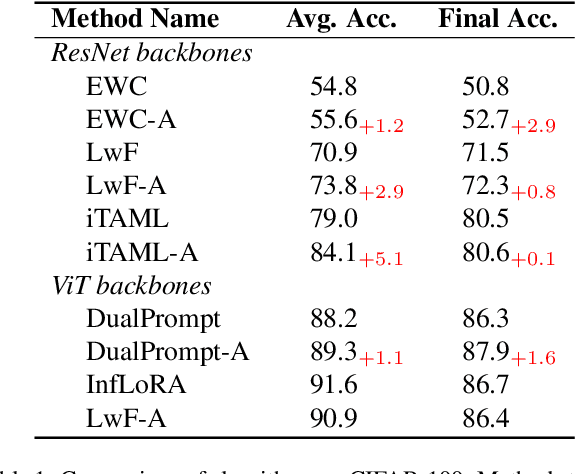
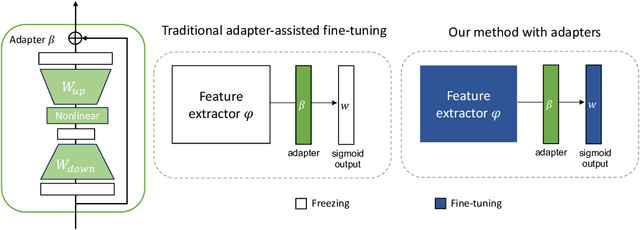

Abstract:Lifelong learning (LL) aims to continuously acquire new knowledge while retaining previously learned knowledge. A central challenge in LL is the stability-plasticity dilemma, which requires models to balance the preservation of previous knowledge (stability) with the ability to learn new tasks (plasticity). While parameter-efficient fine-tuning (PEFT) has been widely adopted in large language models, its application to lifelong learning remains underexplored. To bridge this gap, this paper proposes AdaLL, an adapter-based framework designed to address the dilemma through a simple, universal, and effective strategy. AdaLL co-trains the backbone network and adapters under regularization constraints, enabling the backbone to capture task-invariant features while allowing the adapters to specialize in task-specific information. Unlike methods that freeze the backbone network, AdaLL incrementally enhances the backbone's capabilities across tasks while minimizing interference through backbone regularization. This architectural design significantly improves both stability and plasticity, effectively eliminating the stability-plasticity dilemma. Extensive experiments demonstrate that AdaLL consistently outperforms existing methods across various configurations, including dataset choices, task sequences, and task scales.
IMFine: 3D Inpainting via Geometry-guided Multi-view Refinement
Mar 06, 2025Abstract:Current 3D inpainting and object removal methods are largely limited to front-facing scenes, facing substantial challenges when applied to diverse, "unconstrained" scenes where the camera orientation and trajectory are unrestricted. To bridge this gap, we introduce a novel approach that produces inpainted 3D scenes with consistent visual quality and coherent underlying geometry across both front-facing and unconstrained scenes. Specifically, we propose a robust 3D inpainting pipeline that incorporates geometric priors and a multi-view refinement network trained via test-time adaptation, building on a pre-trained image inpainting model. Additionally, we develop a novel inpainting mask detection technique to derive targeted inpainting masks from object masks, boosting the performance in handling unconstrained scenes. To validate the efficacy of our approach, we create a challenging and diverse benchmark that spans a wide range of scenes. Comprehensive experiments demonstrate that our proposed method substantially outperforms existing state-of-the-art approaches.
TexGen: Text-Guided 3D Texture Generation with Multi-view Sampling and Resampling
Aug 02, 2024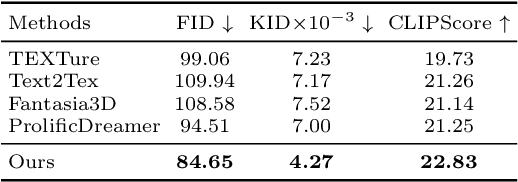
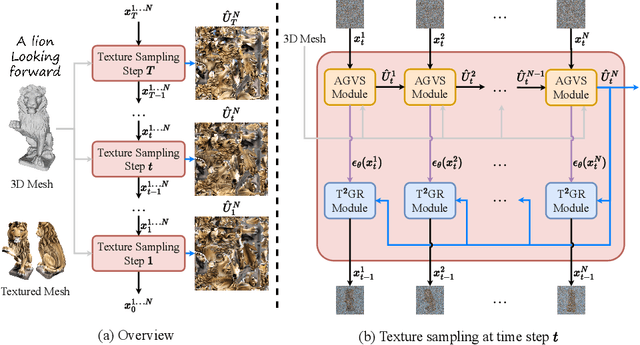

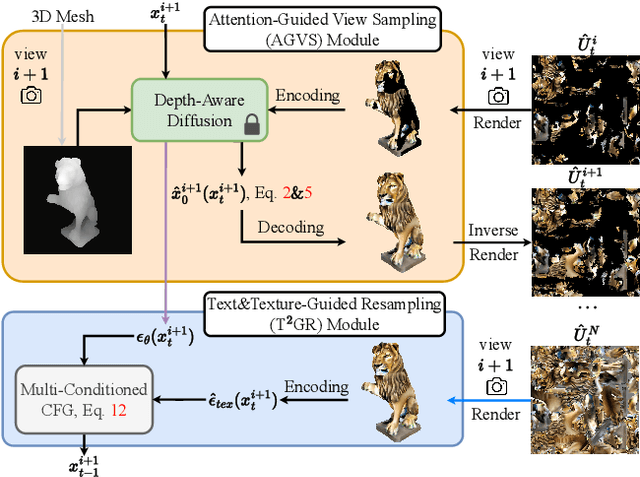
Abstract:Given a 3D mesh, we aim to synthesize 3D textures that correspond to arbitrary textual descriptions. Current methods for generating and assembling textures from sampled views often result in prominent seams or excessive smoothing. To tackle these issues, we present TexGen, a novel multi-view sampling and resampling framework for texture generation leveraging a pre-trained text-to-image diffusion model. For view consistent sampling, first of all we maintain a texture map in RGB space that is parameterized by the denoising step and updated after each sampling step of the diffusion model to progressively reduce the view discrepancy. An attention-guided multi-view sampling strategy is exploited to broadcast the appearance information across views. To preserve texture details, we develop a noise resampling technique that aids in the estimation of noise, generating inputs for subsequent denoising steps, as directed by the text prompt and current texture map. Through an extensive amount of qualitative and quantitative evaluations, we demonstrate that our proposed method produces significantly better texture quality for diverse 3D objects with a high degree of view consistency and rich appearance details, outperforming current state-of-the-art methods. Furthermore, our proposed texture generation technique can also be applied to texture editing while preserving the original identity. More experimental results are available at https://dong-huo.github.io/TexGen/
GSD: View-Guided Gaussian Splatting Diffusion for 3D Reconstruction
Jul 05, 2024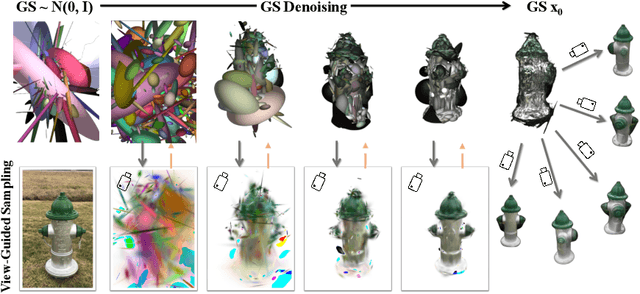

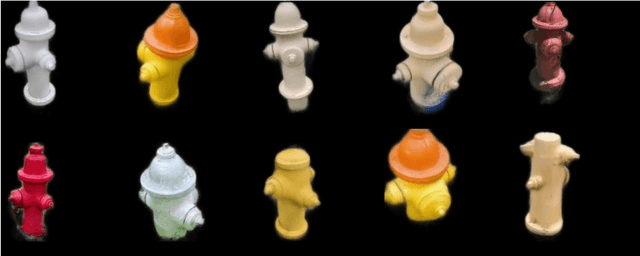

Abstract:We present GSD, a diffusion model approach based on Gaussian Splatting (GS) representation for 3D object reconstruction from a single view. Prior works suffer from inconsistent 3D geometry or mediocre rendering quality due to improper representations. We take a step towards resolving these shortcomings by utilizing the recent state-of-the-art 3D explicit representation, Gaussian Splatting, and an unconditional diffusion model. This model learns to generate 3D objects represented by sets of GS ellipsoids. With these strong generative 3D priors, though learning unconditionally, the diffusion model is ready for view-guided reconstruction without further model fine-tuning. This is achieved by propagating fine-grained 2D features through the efficient yet flexible splatting function and the guided denoising sampling process. In addition, a 2D diffusion model is further employed to enhance rendering fidelity, and improve reconstructed GS quality by polishing and re-using the rendered images. The final reconstructed objects explicitly come with high-quality 3D structure and texture, and can be efficiently rendered in arbitrary views. Experiments on the challenging real-world CO3D dataset demonstrate the superiority of our approach.
Generative Human Motion Stylization in Latent Space
Jan 24, 2024



Abstract:Human motion stylization aims to revise the style of an input motion while keeping its content unaltered. Unlike existing works that operate directly in pose space, we leverage the latent space of pretrained autoencoders as a more expressive and robust representation for motion extraction and infusion. Building upon this, we present a novel generative model that produces diverse stylization results of a single motion (latent) code. During training, a motion code is decomposed into two coding components: a deterministic content code, and a probabilistic style code adhering to a prior distribution; then a generator massages the random combination of content and style codes to reconstruct the corresponding motion codes. Our approach is versatile, allowing the learning of probabilistic style space from either style labeled or unlabeled motions, providing notable flexibility in stylization as well. In inference, users can opt to stylize a motion using style cues from a reference motion or a label. Even in the absence of explicit style input, our model facilitates novel re-stylization by sampling from the unconditional style prior distribution. Experimental results show that our proposed stylization models, despite their lightweight design, outperform the state-of-the-arts in style reeanactment, content preservation, and generalization across various applications and settings. Project Page: https://yxmu.foo/GenMoStyle
Towards 4D Human Video Stylization
Dec 07, 2023Abstract:We present a first step towards 4D (3D and time) human video stylization, which addresses style transfer, novel view synthesis and human animation within a unified framework. While numerous video stylization methods have been developed, they are often restricted to rendering images in specific viewpoints of the input video, lacking the capability to generalize to novel views and novel poses in dynamic scenes. To overcome these limitations, we leverage Neural Radiance Fields (NeRFs) to represent videos, conducting stylization in the rendered feature space. Our innovative approach involves the simultaneous representation of both the human subject and the surrounding scene using two NeRFs. This dual representation facilitates the animation of human subjects across various poses and novel viewpoints. Specifically, we introduce a novel geometry-guided tri-plane representation, significantly enhancing feature representation robustness compared to direct tri-plane optimization. Following the video reconstruction, stylization is performed within the NeRFs' rendered feature space. Extensive experiments demonstrate that the proposed method strikes a superior balance between stylized textures and temporal coherence, surpassing existing approaches. Furthermore, our framework uniquely extends its capabilities to accommodate novel poses and viewpoints, making it a versatile tool for creative human video stylization.
TM2D: Bimodality Driven 3D Dance Generation via Music-Text Integration
Apr 05, 2023



Abstract:We propose a novel task for generating 3D dance movements that simultaneously incorporate both text and music modalities. Unlike existing works that generate dance movements using a single modality such as music, our goal is to produce richer dance movements guided by the instructive information provided by the text. However, the lack of paired motion data with both music and text modalities limits the ability to generate dance movements that integrate both. To alleviate this challenge, we propose to utilize a 3D human motion VQ-VAE to project the motions of the two datasets into a latent space consisting of quantized vectors, which effectively mix the motion tokens from the two datasets with different distributions for training. Additionally, we propose a cross-modal transformer to integrate text instructions into motion generation architecture for generating 3D dance movements without degrading the performance of music-conditioned dance generation. To better evaluate the quality of the generated motion, we introduce two novel metrics, namely Motion Prediction Distance (MPD) and Freezing Score, to measure the coherence and freezing percentage of the generated motion. Extensive experiments show that our approach can generate realistic and coherent dance movements conditioned on both text and music while maintaining comparable performance with the two single modalities. Code will be available at: https://garfield-kh.github.io/TM2D/.
 Add to Chrome
Add to Chrome Add to Firefox
Add to Firefox Add to Edge
Add to Edge